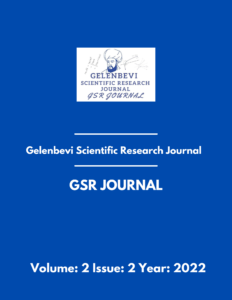
Volume 2, No:2
Gelenbevi Scientific Research Journal: February 2022 Issue
Published May 31, 2022
Full Issue
original article
Social Sciences and Computer Science: New Opportunities and Solutions
Savaş TAKAN*, Duygu ERGÜN TAKAN (*Corresponding author)
Abstract
When we examine the social sciences in their current state and the transformations that will occur as a result of their integration with technology, we can conclude that they are at a crossroads today, as interdisciplinary approaches and fields of study continue to gain prominence. In this sense, new fields of study are bound to emerge. These advancements are inextricably linked to the development of technologies, more specifically, information technologies. The integration of social sciences and technological advancements has mediated and will continue to mediate the emergence of new research areas. Since the 1990s, numerous expressions have been proposed to describe the integration in question, and numerous academic attempts have been made to foster this integration. Unfortunately, many universities continue to face barriers or prejudices when it comes to integrating social sciences and informatics sciences. This situation creates a slew of difficulties for academics conducting research in the field and jeopardizes scientific advances generated by interdisciplinary projects. The primary objective is to mediate in order to overcome these entrenched prejudices and thus contribute to the removal of numerous material and moral barriers that prevent universities from investing in this field. In this context, the term “socioinformatics” has been proposed in the article to refer to the fusion of social sciences and information sciences. The significance and necessity of the time period have been explained, and an attempt has been made to sketch its framework.
Cite as: TAKAN Savaş, ERGÜN TAKAN Duygu. Social Sciences and Computer Science: New Opportunities and Solutions. Gelenbevi Scientific Research Journal, 2022; 2:2, 1-14.
CASE REPORT
Aesthetic Rehabilitation of Diastema and Polydiastema Cases with Direct Composite Resin Restorations: 3-Case Reports
Ayşenur ALTUĞ YILDIRIM*, Mine Betül ÜÇTAŞLI (*Corresponding author)
Abstract
Diastema is a term describing the spaces between teeth, often seen in anterior teeth. The presence of more than one diastema is called polydiastema. Many etiological factors are held responsible for the formation of diastema. Hypertrophic frenulum, genetics, anterior traumatic bite, tongue thrusting, habits such as finger and/or lip sucking, wedge laterals, supernumerary teeth, mesiodens, microdontia, missing tooth, tooth-arch
size mismatch, buccal angulation, odontoma and cysts are some of these. Childhood diastema, called ugly duckling, seen in the anterior region as a result of the pressure applied to the lateral tooth roots by the upper
canines during the transition to the permanent dentition, is a physiological condition and is considered normal. Permanent diastemas can be closed with orthodontic, prosthetic and restorative treatments because they negatively affect aesthetics and function. Advances in adhesion in today’s dentistry allow the aesthetic rehabilitation of diastemas with direct composite resin restorations. The aim of this case series is to describe the aesthetic rehabilitation of patients with diastema and polydiastemas using different techniques with direct composite restorations.Cite as: ALTUĞ YILDIRIM Ayşenur, ÜÇTAŞLI Mine Betül. Aesthetic Rehabilitation of Diastema and Polydiastema Cases with Direct Composite Resin Restorations: 3-Case Reports. Gelenbevi Scientific Research Journal, 2022; 2:2, 15-22.
